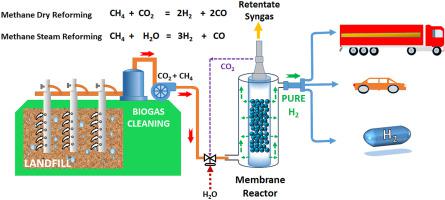当前位置:
X-MOL 学术
›
Renew. Energy
›
论文详情
Our official English website, www.x-mol.net, welcomes your
feedback! (Note: you will need to create a separate account there.)
Hydrogen and/or syngas production through combined dry and steam reforming of biogas in a membrane reactor: A thermodynamic study
Renewable Energy ( IF 9.0 ) Pub Date : 2020-09-01 , DOI: 10.1016/j.renene.2020.05.023 Marcelo Parente , M.A. Soria , Luis M. Madeira
Renewable Energy ( IF 9.0 ) Pub Date : 2020-09-01 , DOI: 10.1016/j.renene.2020.05.023 Marcelo Parente , M.A. Soria , Luis M. Madeira

|
Abstract The possibility of valorizing biogas by producing pure H2 and/or syngas while minimizing the net CO2 emissions was analyzed, combining both dry and steam reforming of biogas. For this purpose, a multifunctional membrane reactor (MR) with a hydrogen permselective membrane was used. The MR, which allows obtaining ultra-pure hydrogen in the permeate side, is compared with a conventional reactor (CR). All analyses were performed from thermodynamic equilibrium calculations based on the Gibbs free energy minimization method. The temperature was varied up to 800 °C and 550 °C for the CR and the MR, respectively. The influence of water addition in the feed on the productivity of hydrogen and CO2 reduction was assessed as well. Results showed that the CR is more suitable to obtain syngas with high purity (only CO and H2) because it allows operating at very high temperatures. The syngas H2/CO ratio can be adjusted for further applications depending on the co-fed amount of water. However, in the permeate side of the MR high-purity hydrogen with a productivity of 73 mol per 100 mol of biogas fed can be obtained. This productivity is equivalent to an H2 production of 131 kg/h, assuming the biogas generation capacity of an existing landfill plant; still, by CO2 recycling, net CO2 emission can be reduced up to 50%.
中文翻译:

通过膜反应器中沼气的联合干法和蒸汽重整生产氢气和/或合成气:热力学研究
摘要 结合沼气的干法和蒸汽重整,分析了通过生产纯 H2 和/或合成气同时最小化净 CO2 排放来使沼气增值的可能性。为此,使用了带有氢选择性渗透膜的多功能膜反应器 (MR)。MR 允许在渗透侧获得超纯氢气,与传统反应器 (CR) 进行了比较。所有分析均根据基于吉布斯自由能最小化方法的热力学平衡计算进行。CR 和 MR 的温度分别高达 800 °C 和 550 °C。还评估了进料中加水对氢气和二氧化碳还原生产率的影响。结果表明,CR 更适合获得高纯度(只有 CO 和 H2)的合成气,因为它允许在非常高的温度下运行。合成气 H2/CO 比率可以根据共同进料的水量调整以用于进一步的应用。然而,在 MR 的渗透侧,可以获得每 100 摩尔沼气的生产率为 73 摩尔的高纯度氢气。假设现有垃圾填埋厂的沼气生产能力,该生产力相当于每小时生产氢气 131 公斤;尽管如此,通过 CO2 回收,净 CO2 排放量最多可减少 50%。假设现有垃圾填埋厂的沼气生产能力,该生产力相当于每小时生产氢气 131 公斤;尽管如此,通过 CO2 回收,净 CO2 排放量最多可减少 50%。假设现有垃圾填埋厂的沼气生产能力,该生产力相当于每小时生产氢气 131 公斤;尽管如此,通过 CO2 回收,净 CO2 排放量最多可减少 50%。
更新日期:2020-09-01
中文翻译:

通过膜反应器中沼气的联合干法和蒸汽重整生产氢气和/或合成气:热力学研究
摘要 结合沼气的干法和蒸汽重整,分析了通过生产纯 H2 和/或合成气同时最小化净 CO2 排放来使沼气增值的可能性。为此,使用了带有氢选择性渗透膜的多功能膜反应器 (MR)。MR 允许在渗透侧获得超纯氢气,与传统反应器 (CR) 进行了比较。所有分析均根据基于吉布斯自由能最小化方法的热力学平衡计算进行。CR 和 MR 的温度分别高达 800 °C 和 550 °C。还评估了进料中加水对氢气和二氧化碳还原生产率的影响。结果表明,CR 更适合获得高纯度(只有 CO 和 H2)的合成气,因为它允许在非常高的温度下运行。合成气 H2/CO 比率可以根据共同进料的水量调整以用于进一步的应用。然而,在 MR 的渗透侧,可以获得每 100 摩尔沼气的生产率为 73 摩尔的高纯度氢气。假设现有垃圾填埋厂的沼气生产能力,该生产力相当于每小时生产氢气 131 公斤;尽管如此,通过 CO2 回收,净 CO2 排放量最多可减少 50%。假设现有垃圾填埋厂的沼气生产能力,该生产力相当于每小时生产氢气 131 公斤;尽管如此,通过 CO2 回收,净 CO2 排放量最多可减少 50%。假设现有垃圾填埋厂的沼气生产能力,该生产力相当于每小时生产氢气 131 公斤;尽管如此,通过 CO2 回收,净 CO2 排放量最多可减少 50%。





























 京公网安备 11010802027423号
京公网安备 11010802027423号